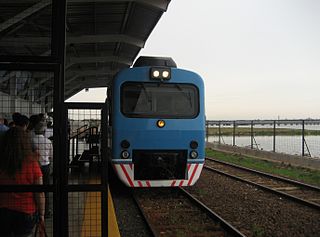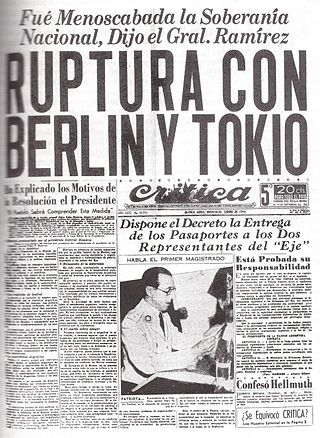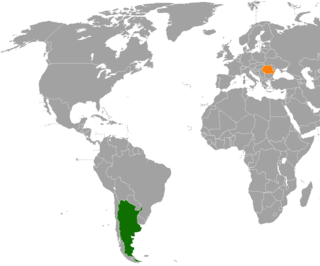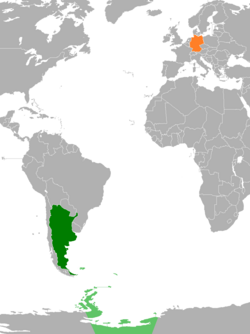This article deals with the diplomatic affairs, foreign policy and international relations of the Argentine Republic. At the political level, these matters are handled by the Ministry of Foreign Affairs, also known as the Cancillería, which answers to the President. The current Minister of Foreign Affairs, since September 2021, is Chancellor Santiago Cafiero.

The Obelisco de Buenos Aires is a national historic monument and icon of Buenos Aires. Located in the Plaza de la República in the intersection of avenues Corrientes and 9 de Julio, it was erected in 1936 to commemorate the quadricentennial of the first foundation of the city.

Carlos Federico Ruckauf is a Peronist politician in Argentina, member of the Justicialist Party. He served as Minister of Foreign Affairs from January 2002 to March 2003. He had earlier served as Vice-President of Argentina from 1995 to 1999, with Carlos Menem, and as his Interior Minister during his first administration. He was twice elected to the National Assembly following the restoration of democratic rule.

The following is an alphabetical list of topics related to the Argentina.

German Argentines are Argentines of German ancestry as well as German citizens living in Argentina. They are descendants of Germans who immigrated to Argentina from Germany and elsewhere in Europe. Some German Argentines originally settled in Brazil, then later immigrated to Argentina. Although Germany as a political entity was founded in 1871, the German language and culture have traditionally been more important than the country of origin, as the basis of the ethnic and national consciousness of Germans. Today, German Argentines make up the fourth-largest ethnic group in Argentina, with over two million citizens of Volga German descent alone.

Alejandro Bustillo was an Argentine painter and architect who designed numerous buildings including iconic landmarks in Buenos Aires, Mar del Plata, and Bariloche.

The General Urquiza Railway (FCGU), named after the Argentine general and politician Justo José de Urquiza, is a standard gauge railway of Argentina which runs approximately northwards from Buenos Aires to Posadas, with several branches in between. It was also one of the six state-owned Argentine railway companies formed after President Juan Perón's nationalisation of the railway network in 1948. The six companies were managed by Ferrocarriles Argentinos which was later broken up during the process of railway privatisation beginning in 1991 during Carlos Menem's presidency.

Argentina and the United States have maintained bilateral relations since the United States formally recognized the United Provinces of the Río de la Plata, the predecessor to Argentina, on January 27, 1823.

Foreign relations between Argentina and France, have existed nearly a century. Both states are members of the G-20.

A current and historical relations between the Argentine Republic and the Italian Republic, for over a century. Both nations enjoy friendly relations, the importance of which centers on the history of Italian migration to Argentina. Argentines of full or partial Italian ancestry number approximately 30 million, or 62% of the country's total population. Both nations are members of the G20 and the United Nations.

The current and historical relations between the Argentine Republic and the Portuguese Republic, have existed for over a century. Both nations are members of the Organization of Ibero-American States and the United Nations.

Foreign relations between the Argentine Republic and the Republic of Peru, have existed for over a century. Both countries established diplomatic relations on July 10, 1822. Both nations are members of the Community of Latin American and Caribbean States, Group of 77, Organization of American States, Organization of Ibero-American States and the United Nations.

Foreign relations between the Argentine Republic and the Oriental Republic of Uruguay have existed for over a century. Both countries were part of the Spanish Empire until the early 19th century.

Foreign relations between Argentina and the Holy See, have existed for over a century. The current pope, Pope Francis, was the former Archbishop of Buenos Aires.

Austrian Argentines are Argentine citizens of Austrian descent or Austrian-born people who emigrated to Argentina. Many Austrian descendants in Argentina arrived in the country from other parts of Europe when Austria was a unified kingdom with Hungary.

Before the start of World War II in 1939, Argentina had maintained a long tradition of neutrality regarding European wars, which had been upheld and defended by all major political parties since the 19th century. One of the main reasons for this policy was related to Argentina's economic position as one of the world's leading exporters of foodstuffs and agricultural products, to Europe in general and to the United Kingdom in particular. Relations between Britain and Argentina had been strong since the mid-19 century, due to the large volume of trade between both countries, the major presence of British investments particularly in railroads and banking, as well as British immigration, and the policy of neutrality had ensured the food supply of Britain during World War I against the German U-boat campaign. At the same time, British influence over the Argentine economy was resented by nationalistic groups, while German and Italian influence in Argentina was strong and growing mainly due to increased interwar trade and investment, and the presence of numerous immigrants from both countries, which, together with the refusal to break relations with the Axis as the war progressed, furthered the belief that the Argentine government was sympathetic to the German cause. Because of strong divisions and internal disputes between members of the Argentine military, Argentina remained neutral for most of World War II, despite pressure from the United States to join the Allies. However, Argentina eventually gave in to the Allies' pressure, broke relations with the Axis powers on 26 January 1944, and declared war on 27 March 1945.

Argentine nationalism refers to the nationalism of Argentine people and Argentine culture. It surged during the War of Independence and the Civil Wars, and strengthened during the 1880s.

Diplomatic relations between the Argentine Republic and Romania, have existed for over a century. Both nations are members of the United Nations.

The Embassy of the Philippines in Buenos Aires is the diplomatic mission of the Republic of the Philippines to the Argentine Republic. First opened in 1949 as the first Philippine diplomatic mission in Latin America, it is currently located in the barrio of Palermo in northern Buenos Aires, near its Chinatown.
































